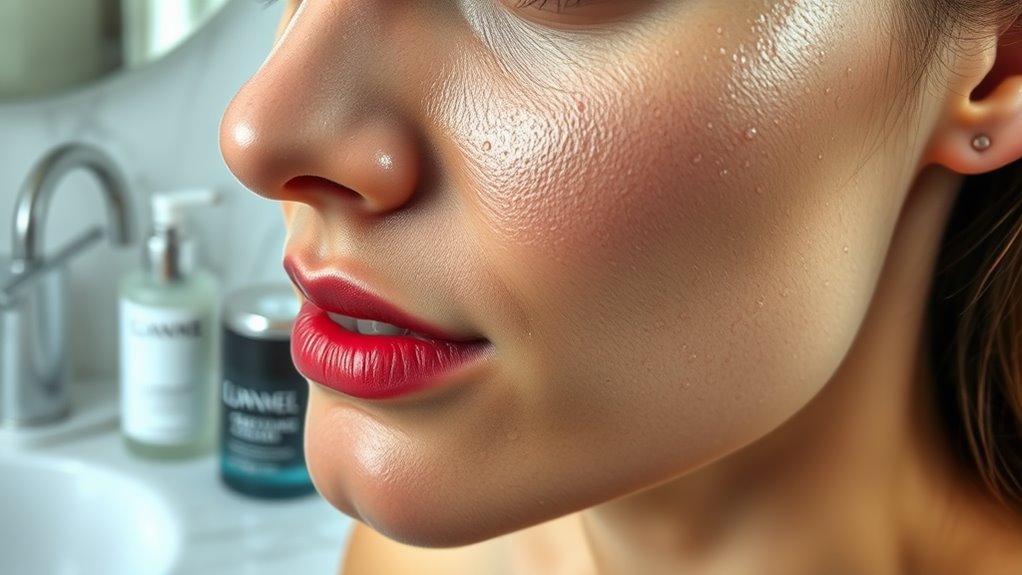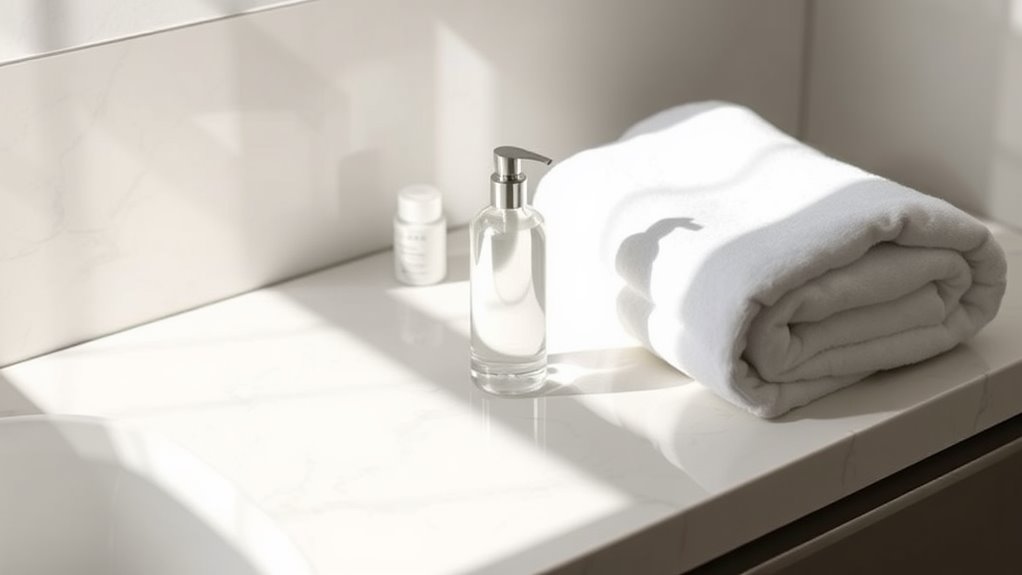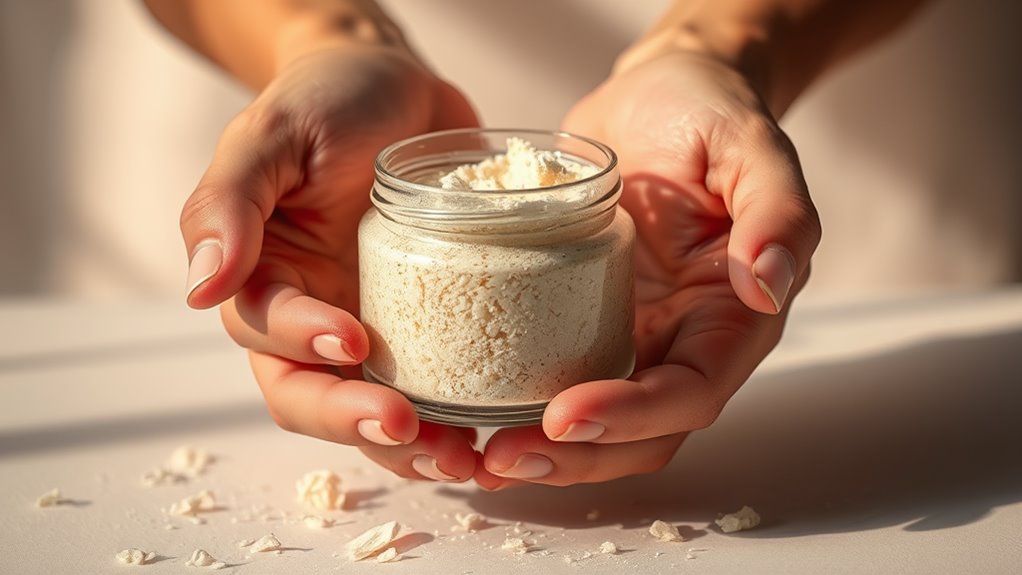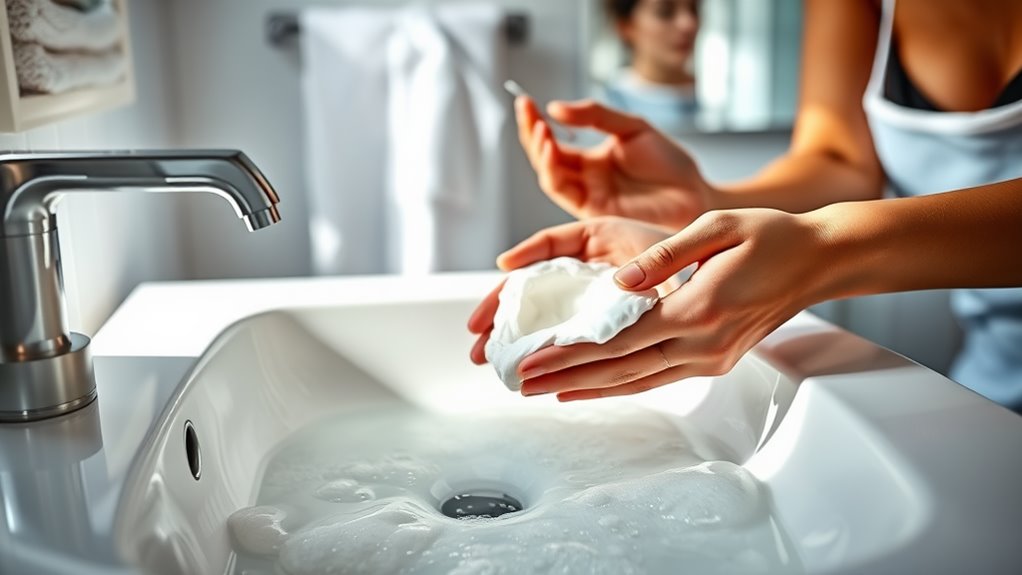Is Your Cleanser Too Harsh. Here’s How to Tell
Your cleanser might be too harsh if it leaves your skin feeling tight, red, or irritated after washing. Other signs include excessive dryness, flakiness, or increased oil production. Look out for ingredients like alcohol and sulfates, which can aggravate your skin. It’s important to maintain a proper pH balance in your cleanser to protect your skin barrier. By knowing these signs, you can choose a suitable product that promotes healthy skin. Discover more effective tips below.
Key Takeaways
- Look for signs like redness, sensitivity, or a burning sensation after cleansing, indicating a harsh cleanser.
- Flakiness or peeling skin can signal over-cleansing or a compromised skin barrier.
- Excess oil production post-cleansing may suggest the skin is reacting to a harsh formula.
- Avoid cleansers with Sodium Lauryl Sulfate, alcohol, or fragrance to prevent irritation and dryness.
- Ensure your cleanser maintains a pH of 4.5 to 5.5 to protect the skin’s natural barrier.
Understanding Your Skin Type
Understanding your skin type is crucial for selecting the right cleanser, especially since using the wrong one can lead to irritation or dryness.
Begin by identifying whether your skin is oily, dry, combination, or sensitive. Oily skin often benefits from gel-based cleansers that cut through excess sebum, while dry skin requires creamier formulas that hydrate. Combination skin may need a balanced approach, targeting both oily and dry areas. If your skin is sensitive, opt for fragrance-free, gentle cleansers that won’t disrupt your skin barrier. Additionally, consider the best cleanser options for each skin type to further enhance your skincare routine.
Signs of a Harsh Cleanser
A harsh cleanser can wreak havoc on your skin, leaving it feeling tight, dry, or irritated.
If you notice increased sensitivity, redness, or a burning sensation after cleansing, your product may be too aggressive. You might also see flakiness or peeling skin, indicating that your cleanser is stripping away essential oils.
Additionally, if your skin produces more oil than usual after washing, it’s a sign your cleanser is over-drying and prompting an oil rebound effect.
Pay attention to any breakouts or inflamed areas, which can suggest your skin barrier is compromised. Choosing the right cleanser for your skin type is crucial to maintaining a healthy complexion.
If you experience any of these symptoms consistently, it’s time to reassess your cleanser and consider switching to a gentler formulation tailored to your skin type.
Ingredients to Avoid
When choosing a cleanser, it’s crucial to be aware of certain ingredients that can harm your skin. Avoiding specific components can help you maintain a healthy complexion. Here are some common ingredients to steer clear of:
| Ingredient | Why to Avoid |
|---|---|
| Sodium Lauryl Sulfate | Can strip natural oils, causing dryness |
| Alcohol | May lead to irritation and dehydration |
| Fragrance | Often a skin irritant, can cause allergic reactions |
Additionally, using cleansers with harsh ingredients can lead to long-term skin damage, so it’s essential to choose wisely.
The Importance of Ph Balance
The Importance of Ph Balance
Maintaining the right pH balance in your cleanser is essential for keeping your skin healthy and functioning properly.
The skin’s natural pH typically hovers around 4.5 to 5.5, which helps protect against harmful bacteria and maintain moisture levels. A cleanser that’s too alkaline can strip your skin of essential oils, leading to dryness and irritation, while an overly acidic formula can also disrupt your skin barrier.
By choosing a cleanser that respects this pH range, you promote optimal skin health, ensuring it remains balanced and resilient. This balance supports your skin’s natural processes, enhancing its ability to fight off environmental stressors and maintain hydration. Additionally, a gentle cleansing routine can provide hydration without over-drying your skin, further preventing irritation.
Ultimately, understanding pH balance is key to selecting the right products for your skincare routine.
How to Test Your Cleanser
To determine if your cleanser is too harsh for your skin, you can perform a simple test that evaluates its effects.
Start by cleansing your face with your product as directed. After rinsing, observe your skin closely for immediate reactions like tightness, redness, or irritation.
Next, wait for about 30 minutes without applying any other products. If your skin feels tight, dry, or uncomfortable during this time, your cleanser may be too aggressive. It’s important to remember that harsh cleansing practices can significantly harm your skin barrier.
Additionally, consider testing the cleanser on a small area of your skin, such as your jawline or behind your ear, to assess its compatibility.
Effects of Over-Cleansing
Over-cleansing can lead to a range of negative effects on your skin, often leaving it more vulnerable than before. When you strip away natural oils, your skin may react by producing excess oil, leading to breakouts. Additionally, you might experience dryness, irritation, and sensitivity.
| Effect | Description | Long-Term Consequence |
|---|---|---|
| Excess Oil Production | Skin compensates for lost moisture | Increased acne risk |
| Dryness | Skin barrier is compromised | Chronic irritation |
| Sensitivity | Heightened response to products | Potential allergic reactions |
| Premature Aging | Loss of elasticity and hydration | Visible fine lines and wrinkles |
Recognizing these effects can help you adjust your cleansing routine to maintain optimal skin health and resilience.
Identifying Skin Sensitivity
Skin sensitivity can often arise as a direct result of over-cleansing or using harsh products. Recognizing your skin’s sensitivity is crucial for maintaining its health.
Here are some telltale signs you should watch for:
- Redness or irritation after cleansing.
- Tightness or discomfort following product application.
- Flaking or peeling, especially in dry areas.
- Breakouts or rashes, occurring unexpectedly.
If you notice these symptoms, it’s essential to assess your current cleansing routine.
Your skin’s reaction is a clear signal that it might be struggling with harsh formulations. Understanding these nuances will empower you to make informed choices, ultimately leading to healthier, more resilient skin.
Mastering this skill is vital for anyone serious about effective skincare.
Choosing the Right Cleanser for Your Skin
Choosing the right cleanser for your skin is essential, especially if you’ve noticed signs of sensitivity. Understanding your skin type can guide your selection process, ensuring you choose a cleanser that effectively removes impurities without causing irritation.
| Skin Type | Recommended Ingredients | Signs of Irritation |
|---|---|---|
| Dry | Hydrating agents, oils | Redness, flakiness |
| Oily | Salicylic acid, gel | Excess shine, breakouts |
| Combination | Balancing formulas | Uneven texture, sensitivity |
Assess your skin’s needs and opt for a gentle formulation. Your goal is to maintain balance and enhance your skin’s natural barrier. By choosing wisely, you can prevent exacerbating any existing sensitivity.
Recommendations for Gentle Cleansers
When selecting a gentle cleanser, pay attention to the ingredients that soothe and hydrate your skin.
Look for formulas specifically designed for your skin type, whether it’s oily, dry, or sensitive.
Understanding these factors will help you find the best gentle cleansers to maintain your skin’s health.
Ingredients to Look For
Finding the right cleanser can significantly impact your skincare routine, particularly if you’re aiming for a gentle touch.
To ensure your cleanser is mild and effective, look for these key ingredients:
-
Glycerin – A powerful humectant that draws moisture to your skin, preventing dryness.
-
Chamomile Extract – Known for its soothing properties, it calms irritation and redness.
-
Aloe Vera – Rich in vitamins and antioxidants, it hydrates while providing anti-inflammatory benefits.
-
Coconut Oil – A natural emollient that helps maintain the skin’s moisture barrier without harshness.
Best Gentle Formulas
Identifying gentle cleansers that align with your skin’s needs can make a significant difference in your daily routine. Look for products featuring soothing ingredients like aloe vera, chamomile, or glycerin.
Brands like CeraVe offer hydrating cleansers enriched with ceramides that help restore your skin’s barrier while effectively cleansing. La Roche-Posay’s Toleriane line is another excellent option, formulated to minimize irritation.
If you prefer a creamier texture, consider using the First Aid Beauty Pure Skin Face Cleanser, which is both gentle and effective. For a minimalist approach, the Vanicream Gentle Facial Cleanser is free from common irritants, making it suitable for sensitive skin.
Choosing any of these gentle formulas can enhance your skincare routine while maintaining your skin’s health.
Skin Type Considerations
Understanding your skin type is essential to selecting a gentle cleanser that effectively meets your needs. Choosing the right product can make all the difference in maintaining your skin’s health and appearance.
Here are some recommendations based on skin type:
-
Oily Skin: Look for gel-based cleansers with salicylic acid to control excess oil.
-
Dry Skin: Opt for cream or oil-based cleansers that hydrate while cleansing.
-
Sensitive Skin: Choose fragrance-free, hypoallergenic formulations to minimize irritation.
-
Combination Skin: Use a gentle foaming cleanser that balances oiliness and dryness.
Establishing a Balanced Skincare Routine
To establish a balanced skincare routine, you first need to identify your skin type.
This understanding will guide you in choosing appropriate products that cater specifically to your skin’s needs.
Identify Skin Type
Knowing your skin type is essential for establishing a balanced skincare routine, as it helps you choose products that cater to your specific needs.
Understanding your skin type empowers you to make informed choices, leading to healthier skin.
Here are four key skin types to identify:
-
Oily: You notice excess shine and enlarged pores, often leading to breakouts.
-
Dry: Your skin feels tight, flaky, or rough, especially after cleansing.
-
Combination: You experience dryness in some areas while others are oily, creating inconsistency.
-
Sensitive: Your skin reacts easily to products, displaying redness or irritation.
Recognizing your skin type is the first step toward a tailored skincare regimen that truly works for you.
Choose Appropriate Products
Selecting the right products for your skincare routine is crucial, especially since the wrong choices can exacerbate skin issues.
Begin by choosing a cleanser that aligns with your skin type—gel-based for oily skin and cream-based for dry skin. Look for non-comedogenic formulas if you’re prone to breakouts.
Incorporate a gentle exfoliant to remove dead skin cells without irritation, but limit its use to avoid over-exfoliation. For hydration, seek a moisturizer with ingredients like hyaluronic acid or ceramides.
Additionally, don’t forget the importance of sunscreen; a broad-spectrum SPF protects against UV damage. Always patch-test new products to prevent adverse reactions.
Crafting a balanced routine tailored to your needs will enhance your skin’s health and appearance.




